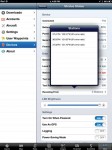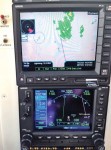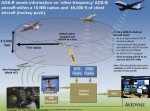by Michael “Mick” Kaufman
In the last issue of Midwest Flyer Magazine, I dedicated part of the column to type-specific flight training for which I will add an additional comment in this issue.
Several issues back, I mentioned flying with your iPad and the evaluation of in-flight weather on the iPad as the core topic for this issue. I was fortunate enough to have spent the last several weeks in sunny Florida managing the flight clinic for the Bonanza/Baron Pilot Training (BPT) program and flying with several of my former instrument students. I was delighted to have had a Stratus Automatic Dependent Surveillance-Broadcast (ADS-B) weather box to use, courtesy of my friend, Pam Freese, from Fredrick, Wisconsin. I would also like to add my congratulations to David Kievet of Stevens Point, Wisconsin for getting his instrument rating in his beautiful, newly acquired Aspin-equipped Bonanza.
When a pilot changes equipment or a cockpit procedure, there needs to be careful planning and he must “proceed with caution.” I often have the privilege of flying much of the new equipment in someone else’s aircraft before I install it in my own aircraft. I used to be the first on the block to own the latest and greatest technology, but not any more. I have been burned with bad products too many times.
I have just installed an iPad mount in my Bonanza using ForeFlight. After evaluating the Stratus box for several weeks, it will be a future go as well.
There are numerous other programs and ADS-B weather boxes out there with each of them having their own special features. I will attempt to give each of them a fair evaluation and will share my findings in future columns.
After speaking to pilots attending the BPT flight clinics, I found that 98% of them are using an iPad in their aircraft and 80% of them are using ForeFlight. I found the Stratus interface to ForeFlight to be one of the easiest I have ever used.
After turning on the Stratus, it is necessary to go to settings and select Stratus as the Wi-Fi network you want to use. The rest is done in ForeFlight by selecting devices. The Stratus box can then interpret the ForeFlight program for information such as the battery condition, and the number of ADS-B ground stations in range, as well as signal quality (see fig. 1). Once you go to the ForeFlight map page, weather information will be displayed the same way it would be if connected to ground-based Wi-Fi or the cellular network. It takes a few minutes to display all of the data after acquiring a ground station on the Stratus box. The age of the data is displayed in the upper left corner of the ForeFlight map page.
ForeFlight allows the pilot to select three items from the menu to be displayed on the map page. This includes a type of map, a choice of aviation VFR sectional charts and IFR low or high altitude charts, or street maps. The graphic weather display on the map has two choices – a radar map or a satellite map – but only one can be selected at a time. The last choice allows the pilot to select from 11 items depending on what the pilot is interested in, but again only one of these items can be selected.
I did not try all of the items in the third group on the Stratus; common sense would tell me that the FAA’s ADS-B service would not provide me with airport fuel prices.
Another item that the Stratus box delivers is a super accurate GPS positioning signal to ForeFlight, and it is displayed in the lower right-hand corner of the map page. It says “Stratus,” and I have seen the accuracy shown as one meter. On the airport page, you can see Metars and TAFs the same as using a ground-based connection.
I did not select any distant airports (more than 500 miles) to see how far from the aircraft that this information was provided. On my XM satellite weather, the entire country is covered. I plotted some radar returns on the Stratus-ForeFlight system against an XM satellite package that was displayed on a Garmin MX 20 Multi-Function Display (MFD) as shown in figures 2 and 3, respectively. Keep in mind that the ForeFlight software only displays north up where the WX displayed on the MX 20 is shown as course up. I see very little difference in the radar display between the two units.
One negative comment that I have heard from pilots on the Stratus-ForeFlight package is that there is no traffic displayed on the screen. Other combinations of ADS-B boxes with iPad software advertise traffic as part of their packages. After investigating this claim, I have to stand behind the decision of the Stratus-ForeFlight developers, as this could be a big liability issue. I have been told that the Stratus is electronically capable of showing traffic, but was disabled by the ForeFlight developers.
In order to get a true picture of traffic, an aircraft must provide an “ADS-B out signal” (signal transmitted by an ADS-B transmitter) to receive all of the traffic in the area. It is like a reverse transponder system or DME. The ADS-B-equipped aircraft sends its GPS position to the ADS-B ground station, and the ground station replies by sending this aircraft all traffic within a 15-mile radius and from 5,000 feet above to 5,000 feet below that aircraft (Figure 4). If you were not flying as a wingman in a tight formation with the “ADS-B out aircraft,” the data you receive passively would not be a true picture of what is out there.
Suppose you were 12 miles away from an ADS-B out aircraft, traffic on the side closest to that aircraft would be correct, but traffic just 3 miles on the other side of you would not be properly displayed. This would give pilots a false sense of security even if they were aware of this feature.
As I change over from all paper to the iPad, I keep playing the devil’s advocate – the iPad could fail in IMC conditions, the battery could go dead, the cigarette lighter charger may not keep the battery alive during a long flight. I see the point of having a second display available, and I understand that ForeFlight allows their program to run on two devices with no extra charge – a great gesture! I will be getting an iPad mini when the new model with the retina display becomes available. After learning that one of the pilots in the Florida Beechcraft clinic reported losing his iPad display due to overheating and he was in IMC weather conditions, I would recommend some type of display redundancy.
On April 5, 2012, 80-year-old Helen Collins made national news by landing a twin-engine airplane at the Door County, Wisconsin airport after her husband had a heart attack and died. Thirty years earlier, her husband had encouraged her to take some training for just such a day. For those of you who remember the news story of this event, the airplane was low on fuel and one engine had quit. Helen did a remarkable landing in this situation, which would have been difficult even for a veteran pilot.
In my last issue of Midwest Flyer Magazine, I dedicated part of the column to type-specific flight training. For the last 20 years that I have been involved in Beechcraft training, there has been a “pilot companion” course. The companion course is structured to teach a pilot’s spouse or flight companion what to do in case the pilot should become incapacitated in flight.
The “Bonanza/Baron Pilot Training” (BPT) program offers two-fold training – classroom-only or classroom, plus flight. The flight option allows the companion to fly in their airplane with a flight instructor in the left seat with concentration on landing the aircraft from the right seat. None of us know if or when this type of training will pay off, but it sure did for Helen Collins. I encourage all pilots to consider adding this type of training for their favorite right-seat passenger.
As we are approaching spring and the busy flying season, learn your equipment well, avoid thunderstorms, and stay out of the ice as the icing season comes to an end. Till the next issue of Midwest Flyer Magazine, “Don’t do anything stupid!” (as quoted from the late Jack Hirsch, Master Beechcraft Instructor) – especially in an airplane!
EDITOR’S NOTE: Michael J. “Mick” Kaufman is a Certified Instrument Flight Instructor (CFII) and the program manager of flight operations with “Bonanza/Baron Pilot Training,” operating out of Lone Rock (LNR) and Eagle River (EGV), Wisconsin. Kaufman was named “FAA’s Safety Team Representative of the Year for Wisconsin” in 2008. Email questions to captmick@me.com or call 817-988-0174.














